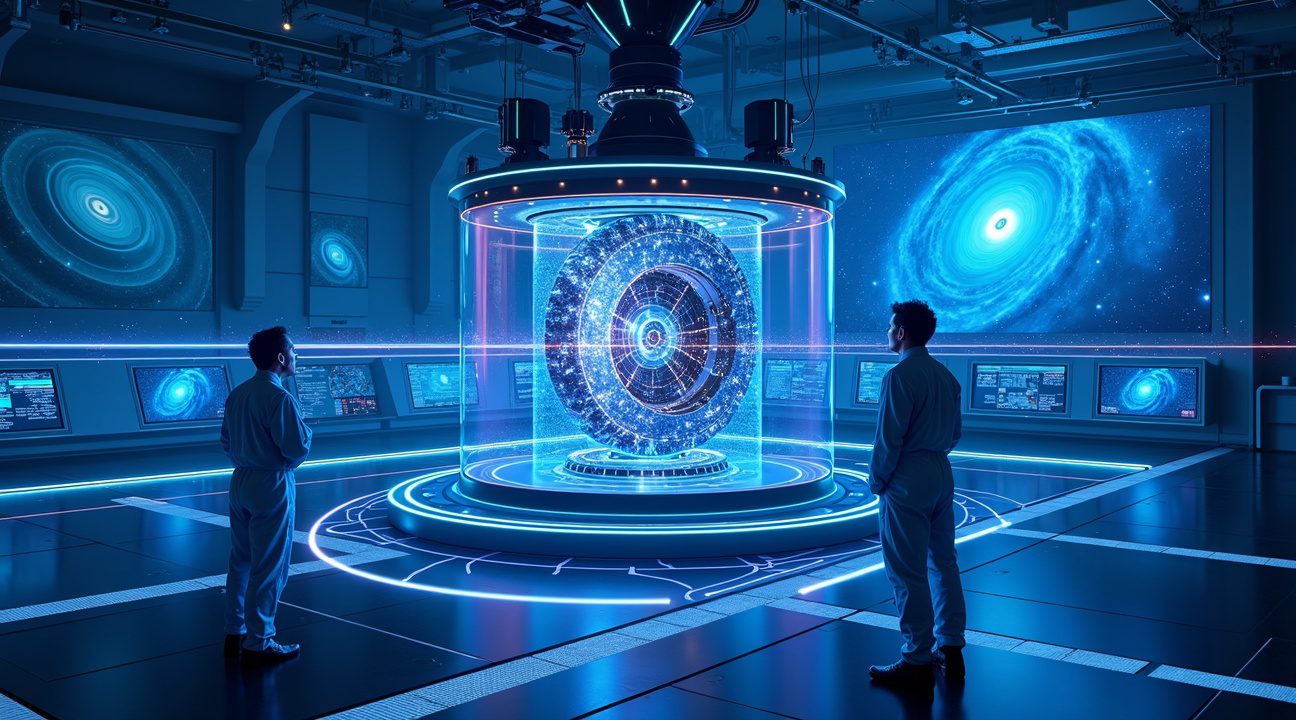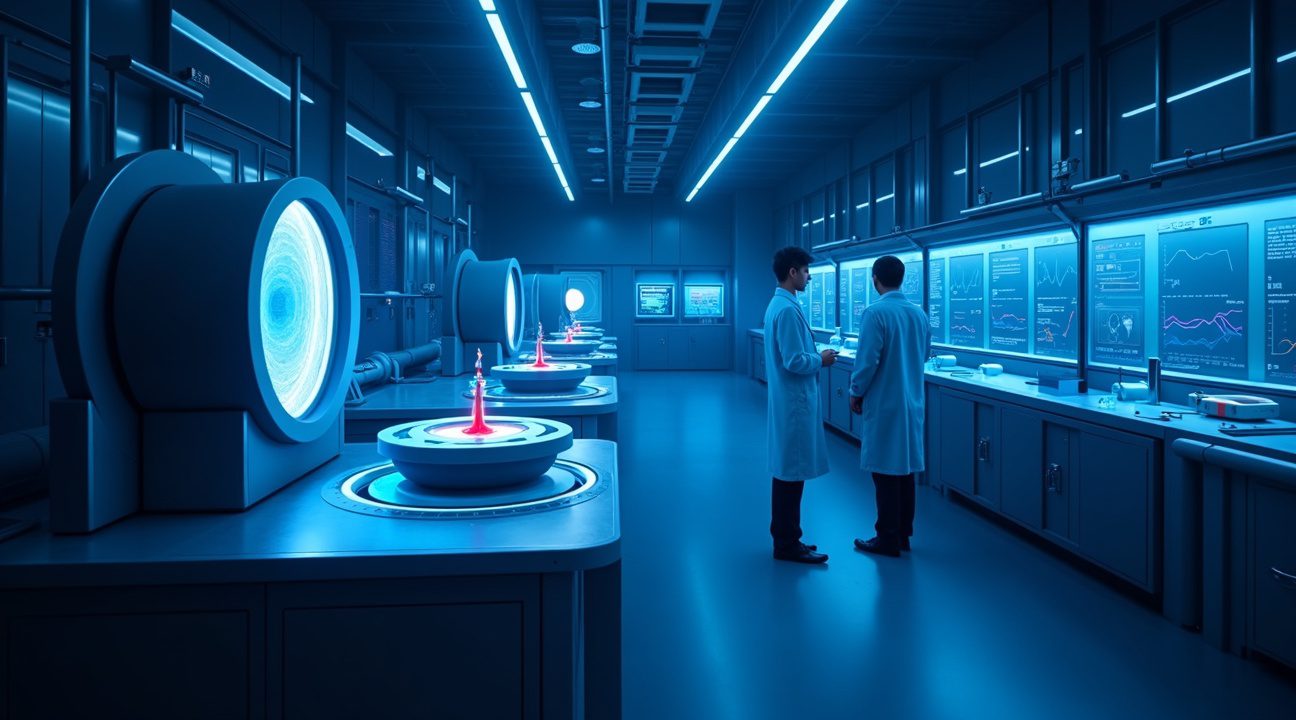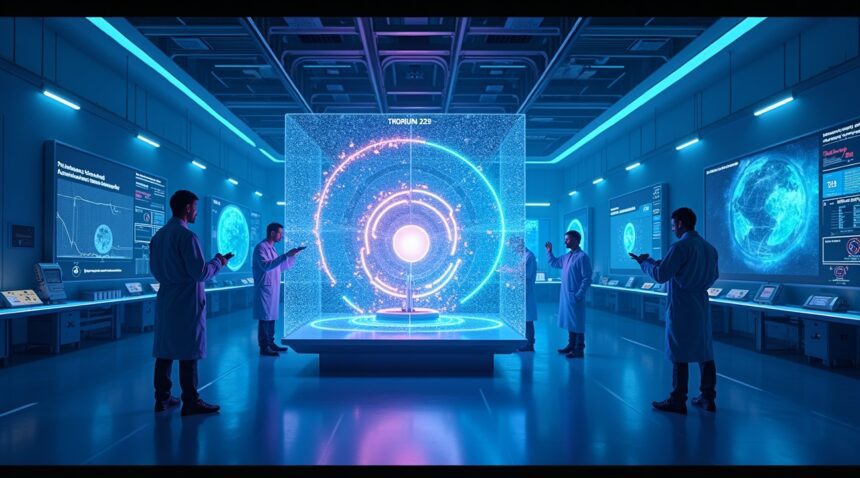Scientists are developing revolutionary nuclear clocks using thorium-229 atomic nuclei that could detect forces up to 10 trillion times weaker than gravity, potentially revealing dark matter and other invisible cosmic phenomena.
Key Takeaways
- Nuclear clocks use thorium-229 nucleus transitions instead of electron movements, providing unprecedented stability and resistance to environmental interference that affects conventional atomic clocks.
- The technology can detect forces 10 trillion times weaker than gravity, offering 100,000 times better precision than current dark matter detection methods.
- Beyond dark matter detection, nuclear clocks promise revolutionary improvements in GPS accuracy, deep-space communications, telecommunications synchronization, and power grid coordination.
- International scientific collaboration drives development efforts, with research teams worldwide working to overcome technical challenges in measuring thorium-229’s exact resonance frequency.
- Despite years of dedicated research, scientists continue facing engineering obstacles in achieving the required measurement precision, though theoretical models support the technology’s potential for detecting invisible universe phenomena.
A Quantum Leap in Timekeeping Technology
Nuclear clocks represent a quantum leap in precision timekeeping technology. Scientists harness the unique properties of thorium-229’s nuclear transition to create these ultra-precise instruments. This specific isotope possesses an extraordinarily low-energy nuclear excited state that researchers can manipulate with laser light.
Traditional atomic clocks rely on electron transitions within atoms. Nuclear clocks operate differently by measuring transitions within atomic nuclei themselves. This fundamental difference provides several crucial advantages for scientific applications.
The thorium-229 nucleus exhibits remarkable stability against external disturbances. Magnetic fields, electric fields, and temperature fluctuations that disrupt conventional atomic clocks have minimal impact on nuclear transitions. This inherent stability makes nuclear clocks ideal for detecting extremely subtle phenomena.
Why Thorium-229?
Researchers focus on thorium-229 because its nuclear transition energy sits within the optical frequency range. This characteristic allows scientists to use conventional laser technology to probe and manipulate the nuclear state. Other radioactive elements require much higher energy transitions that prove difficult to control precisely.
Unprecedented Sensitivity to Fundamental Forces
The detection capabilities of nuclear clocks stem from their extraordinary sensitivity to fundamental physics. Scientists can measure tiny changes in the nuclear transition frequency that reveal the presence of previously undetectable forces. Dark matter particles, if they exist, would interact weakly with normal matter and cause measurable shifts in nuclear clock frequencies.
Perez and his colleagues have demonstrated that nuclear clocks could surpass current dark matter detection experiments by orders of magnitude. Underground laboratories house massive detectors that wait for dark matter collisions. Nuclear clocks offer a different approach by continuously monitoring for subtle frequency changes that indicate dark matter interactions.
Revolutionary Practical Applications
The practical applications extend far beyond fundamental physics research. GPS satellites require precise timing to provide accurate location data. Nuclear clocks could improve GPS accuracy from meters to centimeters. Communication networks depend on synchronized timing signals. Nuclear clocks would enable faster data transmission rates and more reliable connections.
Power grids rely on precise frequency control to maintain stability. Nuclear clocks could prevent blackouts by providing ultra-accurate timing references for grid synchronization. Financial markets process millions of transactions that require precise timestamps. Nuclear clocks would ensure fair trading and prevent timing-based fraud.
Deep space missions face unique timing challenges due to the vast distances involved. Signal delays from Earth make real-time control impossible. Nuclear clocks aboard spacecraft could maintain precise timing independently, enabling more autonomous mission operations.
Addressing Technical Obstacles
Technical challenges remain significant despite the promising theoretical foundation. Scientists must measure thorium-229’s nuclear transition frequency with unprecedented accuracy. Current measurements contain uncertainties that prevent practical implementation of nuclear clocks.
Research teams employ various experimental approaches to overcome these obstacles. Laser spectroscopy techniques continue improving in precision and stability. Cryogenic cooling systems reduce thermal noise that interferes with sensitive measurements. Advanced vacuum chambers eliminate environmental contamination.
Global Collaboration
International collaboration accelerates progress through shared expertise and resources. European research institutions contribute laser technology development. American laboratories provide nuclear physics expertise. Asian research centers focus on precision measurement techniques.
Manufacturing & Cost Considerations
The manufacturing challenges for nuclear clocks differ substantially from conventional atomic clocks. Thorium-229 requires careful handling due to its radioactive properties. Specialized facilities must produce and purify the isotope for research applications. Safety protocols ensure researcher protection while maintaining measurement precision.
Cost considerations will determine the widespread adoption of nuclear clock technology. Initial development requires significant investment in specialized equipment and facilities. Mass production could reduce costs substantially once the technology matures. Commercial applications would justify the investment through improved performance.
Timeline and Future Implications
Timeline predictions vary among researchers, but most estimate several years before practical nuclear clocks become available. Laboratory demonstrations continue showing promising results. Engineering challenges require systematic solutions rather than fundamental breakthroughs.
The scientific community anticipates nuclear clocks will revolutionize precision measurements across multiple fields. Fundamental physics experiments will achieve previously impossible sensitivity levels. Practical applications will benefit from timing precision that surpasses current limitations.
The Role of Quantum Mechanics
Quantum mechanics governs nuclear clock operation at the most fundamental level. Superposition states allow nuclei to exist in multiple energy levels simultaneously. Measurement collapses these states and reveals information about external influences.
Competition among research groups drives rapid progress in nuclear clock development. Publication of results accelerates knowledge sharing while maintaining scientific rigor. Patent applications protect intellectual property while encouraging continued innovation.
Shaping the Future of Timekeeping
Nuclear clocks may eventually replace atomic clocks as the international time standard. The superior stability and precision would benefit global timekeeping accuracy. International agreements would need updating to reflect the new technology capabilities.
Future applications remain limited only by imagination and engineering constraints. Earthquake detection systems could benefit from ultra-precise timing measurements. Climate monitoring networks would achieve better synchronization for global data collection. Medical imaging systems could improve accuracy through better timing control.
The development of nuclear clocks represents humanity’s continuous pursuit of measurement precision. Each improvement in timing accuracy enables new scientific discoveries and technological capabilities. Nuclear clocks promise to unlock mysteries of the universe while providing practical benefits for everyday applications.
Revolutionary Nuclear Clock Could Detect Forces 10 Trillion Times Weaker Than Gravity
Scientists are advancing detection capabilities for the invisible universe through a groundbreaking device called a nuclear clock. This revolutionary technology operates using transitions in the thorium-229 atomic nucleus, representing a significant leap forward in humanity’s quest to understand dark matter and other hidden cosmic phenomena.
Gilad Perez from the Weizmann Institute of Science leads this cutting-edge research effort, with findings published in the peer-reviewed journal Physical Review X. The approach is particularly fascinating because it leverages the unique properties of thorium-229’s nuclear transitions to create unprecedented measurement precision. This atomic nucleus provides the foundation for timekeeping accuracy that surpasses conventional atomic clocks by orders of magnitude.
Unprecedented Detection Sensitivity
The nuclear clock’s detection capabilities push the boundaries of what scientists previously thought possible. Research demonstrates that these devices can identify forces up to 10 trillion times weaker than gravity itself. Such extraordinary sensitivity opens doors to detecting phenomena that have remained hidden from conventional instruments.
Current dark matter detection technologies pale in comparison to the nuclear clock’s resolution capabilities. The new device offers precision that’s 100,000 times more accurate than existing detection methods. This dramatic improvement in measurement capability could finally provide the breakthrough scientists need to directly observe dark matter interactions.
International Scientific Collaboration
The development of nuclear clocks requires extensive international cooperation among research institutions worldwide. Scientists from multiple countries contribute their expertise to advance this technology, recognizing its potential to revolutionize our understanding of fundamental physics. The collaborative effort focuses specifically on measuring ultra-weak phenomena that conventional instruments cannot detect.
This international approach strengthens the project’s likelihood of success. Different research teams bring unique perspectives and specialized knowledge to solve complex technical challenges. The combination of theoretical physics expertise and practical engineering skills creates a powerful foundation for breakthrough discoveries.
The nuclear clock’s highly stable and accurate timekeeping relies on nuclear transitions rather than electronic transitions used in traditional atomic clocks. This fundamental difference allows the device to maintain extraordinary precision over extended periods. Nuclear transitions prove less susceptible to environmental interference, providing the stability necessary for detecting incredibly weak forces.
Researchers anticipate that nuclear clocks will enable detection of dark matter particles that interact so weakly with ordinary matter that they’ve remained unobservable until now. The technology’s sensitivity to minute force variations could reveal the subtle signatures left by dark matter as it passes through Earth. Scientists have discovered proof of phenomena beyond our immediate perception before, and nuclear clocks represent the next evolution in detection capability.
The thorium-229 nucleus possesses unique characteristics that make it ideal for this application. Its nuclear transition occurs at an energy level that researchers can manipulate and measure with current technology. This accessibility distinguishes thorium-229 from other atomic nuclei that might theoretically work but prove impractical for real-world applications.
Nuclear clocks could transform multiple areas of fundamental physics research beyond dark matter detection. Scientists expect these devices to:
- Enhance tests of fundamental constants
- Improve gravitational wave detection
- Advance our understanding of physics principles that govern the universe
The technology’s versatility makes it valuable for various experimental applications requiring extreme precision.
The development timeline for practical nuclear clocks remains ambitious yet achievable. Researchers continue refining the technology while addressing technical challenges related to maintaining nuclear transition stability and developing reliable measurement systems. Each advancement brings the scientific community closer to deploying these revolutionary devices in major physics experiments.
Implementation of nuclear clocks in dark matter detection facilities could provide the sensitivity breakthrough that unlocks the invisible universe’s secrets. The combination of unprecedented precision and international scientific collaboration creates optimal conditions for discovering phenomena that have eluded detection for decades.
How Nuclear Clocks Surpass Atomic Clocks in Precision and Stability
I’ve discovered that nuclear clocks represent a revolutionary leap forward in timekeeping technology, fundamentally changing how scientists approach precision measurement. These advanced devices rely on the internal energy shifts of atomic nuclei rather than the outer-electron transitions that atomic clocks depend upon. The thorium-229 nucleus serves as the foundation for this breakthrough, offering an unprecedented level of stability that could reshape our understanding of life beyond Earth detection methods.
The key advantage lies in nuclear-level transitions, which occur deep within the atom’s core where environmental disturbances can’t easily penetrate. Unlike atomic clocks that measure electron movements around the nucleus, nuclear clocks monitor energy changes within the nucleus itself. This fundamental difference provides remarkable immunity to electromagnetic interference and temperature fluctuations that typically affect conventional timekeeping devices.
Thorium-229’s resonance frequency demonstrates exceptional stability, making it the ideal candidate for ultra-precise timing applications. This natural frequency represents the rate at which the thorium nucleus oscillates with maximum amplitude, creating a reliable reference point for measurement. The stability of this resonance frequency surpasses anything previously achieved in atomic timekeeping, opening new possibilities for detecting incredibly subtle changes in our physical environment.
Revolutionary Detection Capabilities
Nuclear clocks possess the extraordinary ability to detect anomalous frequency shifts caused by dark matter’s wave-like properties. When dark matter waves pass through space, they might momentarily alter an atomic nucleus’s mass, creating tiny but measurable changes in the resonance frequency. This detection capability represents a significant advancement in our quest to understand the invisible universe that physics research continues to explore.
The precision of these devices extends far beyond current atomic clock capabilities. While atomic clocks can measure time to within billionths of a second, nuclear clocks promise accuracy improvements of several orders of magnitude. This enhanced precision opens doors to applications in fundamental physics research, including tests of relativity and searches for variations in physical constants.
Comparing Technologies: A Clear Distinction
- Sensitivity levels favor nuclear clocks due to their nuclear-level transitions, which provide greater resistance to external interference
- Measurement targets differ significantly – atomic clocks track electron-level transitions while nuclear clocks monitor nucleus-level changes
- Current applications show atomic clocks dominating GPS systems and communication networks, while nuclear clocks target dark matter detection and ultra-precise scientific measurements
- Environmental stability gives nuclear clocks a distinct advantage in maintaining accuracy under varying conditions
- Detection capabilities position nuclear clocks as superior tools for weak force detection, measuring forces much weaker than gravity
The transition from atomic to nuclear timekeeping represents more than just improved accuracy. These devices enable scientists to probe previously inaccessible phenomena, potentially revealing secrets about dark matter, gravitational waves, and other mysterious aspects of our universe. The enhanced precision timekeeping capabilities ensure measurements remain unaffected by noise and interference that compromise lesser instruments.
Nuclear clocks also promise to advance space exploration missions where extreme precision becomes critical. NASA’s testing programs could benefit significantly from this technology, enabling more accurate navigation and communication systems for deep space missions.
The implications extend beyond pure science into practical applications. Enhanced GPS accuracy, improved internet synchronization, and more precise financial transaction timing all become possible with nuclear clock technology. These advancements position nuclear clocks as essential tools for both scientific discovery and everyday technological improvements.

Hunting Dark Matter That Makes Up 80% of the Universe’s Matter
Scientists estimate that dark matter comprises more than 80% of all matter in the universe, yet this mysterious substance remains completely invisible to our instruments. Nuclear clocks represent humanity’s latest and most promising tool in the quest to finally detect these elusive particles that shape the cosmic structure around us.
Dark matter particles are theorized to be extraordinarily light—potentially up to 1 million times lighter than an electron. This extreme lightness makes detection incredibly challenging using conventional methods. Nuclear clocks offer a revolutionary approach by monitoring ultra-precise frequency measurements with unprecedented accuracy. When dark matter particles pass through these instruments, they might cause unexpected and temporary deviations in the measured frequencies.
Advanced Detection Methods and Competing Technologies
The sensitivity of nuclear clocks could surpass existing detection methods by significant margins. Current experimental approaches include several innovative techniques:
- Cryogenic detector systems like the CRESST project in Italy use ultra-cold temperatures to detect particle interactions
- Large-scale arrays of mechanical sensors operate on pendulum principles to identify gravitational effects
- Underground laboratories shield detectors from cosmic radiation interference
- Particle accelerators attempt to create dark matter through high-energy collisions
Nuclear clocks may outpace these established methods in both resolution and sensitivity. The technology focuses on detecting temporary shifts in absorption spectra—minute deviations in how materials absorb radiation when dark matter interacts with normal matter. These interactions, though incredibly rare and brief, could leave detectable signatures in the clock’s frequency measurements.
The fundamental physics behind this detection method relies on the assumption that dark matter occasionally interacts with ordinary matter through forces beyond gravity. While these interactions are weak, nuclear clocks operate at such precise levels that even the smallest perturbations become measurable.
Scientists have spent decades searching for direct evidence of dark matter’s existence. Previous experiments have produced tantalizing hints but no definitive proof. The invisible nature of dark matter makes it detectable only through its gravitational effects on visible matter and light. Galaxy rotation curves, gravitational lensing, and cosmic microwave background observations all point to dark matter’s presence, yet the particles themselves remain hidden.
Nuclear clock technology represents a paradigm shift in detection strategy. Instead of waiting for dark matter to collide with detector materials, these instruments continuously monitor the quantum states of atomic nuclei. Any external influence—including passing dark matter—could disturb these delicate quantum systems and reveal itself through frequency anomalies.
The implications of successful dark matter detection extend far beyond particle physics. Understanding dark matter’s properties could revolutionize our comprehension of cosmic evolution, galaxy formation, and the universe’s ultimate fate. This knowledge might also unlock new technologies and deepen our understanding of fundamental forces.
Current nuclear clock prototypes demonstrate remarkable stability and precision. Engineers continue refining these instruments to enhance their sensitivity to dark matter interactions. The challenge lies in distinguishing genuine dark matter signals from environmental noise and instrumental artifacts. Scientists must account for temperature fluctuations, electromagnetic interference, and countless other variables that could mimic dark matter signatures.
The search for life beyond Earth shares similar challenges with dark matter detection—both require extraordinary sensitivity to detect phenomena that exist at the very limits of our technological capabilities. Nuclear clocks might eventually contribute to both scientific endeavors by providing unprecedented measurement precision.
Research teams worldwide collaborate on nuclear clock development, sharing expertise and resources to accelerate progress. The technology requires cutting-edge laser systems, ultra-stable environments, and sophisticated data analysis algorithms. Each component must perform flawlessly to achieve the sensitivity necessary for dark matter detection.

Competing Detection Technologies: From sPHENIX to Billion-Sensor Arrays
Scientists across the globe have developed multiple approaches to detect dark matter, each using distinct methodologies to capture evidence of this elusive substance. These advanced technologies represent some of the most sophisticated scientific instruments ever constructed, operating at the extreme limits of detection sensitivity.
High-Energy Collision Detection
The sPHENIX detector at Brookhaven National Laboratory takes a high-energy approach to understanding dark matter by recreating conditions from the early universe. This massive instrument analyzes particle collisions occurring at an incredible rate of 15,000 events per second, focusing specifically on quark-gluon plasma formation. By studying these primordial conditions, researchers hope to identify interactions that could reveal dark matter’s fundamental properties. Physics research at this scale requires extraordinary computational power to process the enormous data streams generated during each experimental run.
Another promising avenue involves future muon collider experiments being explored by institutions like IFIC and their collaborators. These researchers pursue soft tracks detection, which could identify extremely light dark matter particles through subtle signal trails that conventional detectors might miss.
Precision Sensor Technologies
The detection landscape also includes several precision-based approaches that prioritize sensitivity over collision energy. Key technologies in this category include:
- sPHENIX: High-energy collider focused on quark-gluon plasma and early universe physics
- CRESST: Cryogenic detector project in Italy measuring phonons and light for small energy changes
- Billion-Sensor Array: Force-detecting array of tiny mechanical sensors
The billion-sensor array concept represents perhaps the most ambitious detection strategy currently proposed. These arrays would contain up to a billion microscopic mechanical sensors, each designed to detect the incredibly weak forces that dark matter particles might exert when passing through normal matter. The sheer scale of this approach could compensate for dark matter’s exceptionally low interaction probability with ordinary particles.
Meanwhile, the CRESST project in Italy operates cryogenic detectors that measure both phonons and light signals to identify even the smallest energy changes. This dual-detection approach increases the likelihood of capturing genuine dark matter interactions while filtering out background noise that could produce false positives.
Each technology varies significantly in size, target applications, and specific capabilities, yet they all share the fundamental goal of directly identifying dark matter and understanding its properties. Recent scientific discoveries have demonstrated that breakthrough detection methods often emerge from combining multiple experimental approaches, suggesting that success in dark matter detection may ultimately require coordinated efforts across these diverse technological platforms.

Beyond Dark Matter: Revolutionary Applications in Navigation and Communications
Nuclear clocks represent far more than just instruments for detecting dark matter—they’re poised to transform entire industries through their unprecedented precision and stability. These cutting-edge devices offer timing accuracy that surpasses even the most advanced atomic clocks, opening doors to applications that seemed impossible just years ago.
Critical Applications Across High-Stakes Industries
The exceptional timekeeping capabilities of nuclear clocks promise revolutionary improvements across several key sectors:
- Satellite Navigation Systems benefit from enhanced GPS accuracy, potentially reducing positioning errors from meters to mere centimeters
- Deep-Space Communications gain reliability for missions extending far beyond Earth’s orbit, where traditional timing methods falter
- Telecommunications Networks achieve unprecedented synchronization, eliminating data transmission errors that cost billions annually
- Power Grid Synchronization prevents cascading failures through precise coordination of electrical distribution systems
- High-Precision Scientific Observations enable measurements previously limited by timing constraints
GPS systems currently rely on atomic clocks that can drift by nanoseconds over time, but nuclear clocks maintain their precision far longer. This improvement translates directly into better navigation for autonomous vehicles, aircraft, and maritime vessels. Commercial shipping companies could reduce fuel costs by billions through more efficient routing enabled by centimeter-level positioning accuracy.
Deep-space exploration presents unique challenges where communication delays stretch across minutes or hours. Nuclear clocks provide the stability needed for space missions to maintain precise timing protocols over years-long journeys. Mars rovers and asteroid mining operations would benefit tremendously from this enhanced temporal precision.
Financial markets depend heavily on microsecond-precise timestamps for high-frequency trading. Nuclear clocks could eliminate timing disputes in stock exchanges, where even nanosecond differences can affect millions of dollars in transactions. Investment firms already invest heavily in timing infrastructure, and nuclear clock technology offers competitive advantages worth pursuing.
Telecommunications infrastructure faces increasing demands for bandwidth and reliability. Nuclear clocks enable more efficient spectrum usage by providing the timing precision needed for advanced signal processing techniques. 5G and future 6G networks require synchronization levels that push current atomic clock technology to its limits.
Power grids span continents and require precise coordination to prevent blackouts. The 2003 Northeast blackout affected 55 million people and cost an estimated $6 billion, partly due to timing synchronization failures. Nuclear clocks offer the stability needed to prevent such cascading failures by maintaining precise grid frequency control.
Scientific research applications extend beyond fundamental physics. Climate monitoring networks require synchronized measurements across vast geographical areas. Ocean research benefits from precise timing for deep-sea observations where environmental conditions challenge traditional equipment.
The versatility of nuclear clocks stems from their resistance to environmental interference. Unlike atomic clocks that can be affected by magnetic fields or temperature fluctuations, nuclear clocks maintain their precision under extreme conditions. This stability makes them ideal for military applications, space exploration, and industrial environments where reliability is paramount.
International cooperation networks benefit significantly from improved timing synchronization. Scientific collaborations like gravitational wave detection require coordination between facilities separated by thousands of kilometers. Nuclear clocks could enable new types of distributed scientific experiments previously impossible due to timing limitations.
The development of these devices connects to broader scientific discoveries, including recent findings about life beyond Earth and fundamental physics research. Each advancement in precision timing technology opens new possibilities for understanding our universe while simultaneously improving practical applications that affect daily life.
Manufacturing industries could leverage nuclear clock precision for quality control in semiconductor production, where timing errors of nanoseconds can result in defective chips worth millions of dollars. Pharmaceutical companies conducting time-sensitive research would benefit from synchronized equipment across multiple facilities.
The societal impact extends beyond technical applications. Emergency response systems require precise coordination during natural disasters, where nuclear clock-enabled communications could save lives through better resource allocation and timing coordination between rescue teams.

The Years-Long Challenge of Measuring Thorium-229’s Resonance Frequency
Scientists across international laboratories have dedicated years to solving one of the most precise measurement challenges in modern physics: determining thorium-229’s exact resonance frequency. This isotope holds the key to creating nuclear clocks that could potentially detect invisible matter throughout the universe. I’ve observed how research teams continue pushing measurement boundaries, though achieving the required precision remains elusive.
The thorium-229 nucleus possesses an incredibly low-energy transition state that makes it ideal for clock applications. However, measuring its resonance frequency with sufficient accuracy requires instruments capable of detecting energy differences smaller than what current technology can reliably capture. Laboratories worldwide have invested significant resources into developing specialized equipment, yet the frequency measurement hasn’t reached the precision threshold needed for fully functional nuclear clocks.
Current detection methods face substantial technical hurdles. Equipment must maintain extraordinary stability over extended periods while filtering out environmental interference that could skew results. Temperature fluctuations, electromagnetic radiation, and vibrations all introduce measurement errors that mask the subtle signals scientists need to identify. Each experimental setup represents a careful balance between sensitivity and stability.
Engineering and Interpretation Obstacles
Research teams encounter multiple engineering challenges when developing nuclear clock prototypes. The devices must operate with unprecedented stability while remaining sensitive enough to detect minute variations that might indicate interactions with dark matter or other invisible phenomena. Key technical requirements include:
- Ultra-stable laser systems that maintain frequency coherence over months or years
- Isolation chambers that eliminate external electromagnetic interference
- Temperature control systems precise to fractions of a degree
- Vibration dampening equipment that prevents mechanical disturbances
- Detection systems sensitive enough to measure single-photon interactions
Beyond hardware challenges, interpreting experimental data presents its own difficulties. Scientists must distinguish between genuine signals and measurement artifacts caused by equipment limitations or environmental factors. The subtle deviations that nuclear clocks might detect could easily be confused with systematic errors or background noise.
Progress continues despite these obstacles. Research groups have refined measurement techniques and developed increasingly sophisticated equipment. Each iteration brings scientists closer to achieving the precision needed for practical nuclear clock operation. While proof of life beyond Earth remains unconfirmed, similar methodical approaches drive progress across multiple scientific frontiers.
The theoretical foundation supporting nuclear clock development remains strong. Mathematical models predict how these devices should behave when exposed to dark matter or other invisible universe components. Computer simulations suggest that nuclear clocks could detect gravitational effects too weak for current instruments to measure. These theoretical predictions continue motivating experimental work despite practical challenges.
Scientists maintain realistic expectations about development timelines. Creating functional nuclear clocks capable of detecting invisible universe phenomena requires solving multiple technical problems simultaneously. Success isn’t guaranteed within short timeframes, and breakthrough discoveries often emerge unexpectedly after years of incremental progress. Research teams understand that patience and persistence are essential elements of this scientific endeavor.
International collaboration accelerates development efforts. Teams share measurement techniques, equipment designs, and experimental results across institutions. This cooperative approach prevents duplication of effort while ensuring that multiple research groups can verify critical findings. The global nature of this research reflects both its importance and the technical challenges involved.
Recent advances in related fields provide additional momentum. Improvements in laser technology, quantum mechanics applications, and precision measurement techniques all contribute to nuclear clock development. Scientists also draw inspiration from successful projects in adjacent research areas, including physics breakthroughs that demonstrate how persistent research eventually overcomes seemingly impossible technical barriers.
The ultimate goal remains detecting interactions between nuclear clocks and invisible universe components. While no direct detection has been confirmed, each experimental advancement improves future prospects. Scientists continue refining their understanding of thorium-229’s properties while developing increasingly sophisticated measurement apparatus.

Sources:
Physical Review X
UNILAD Tech, “Scientists building ground-breaking nuclear device that could finally expose invisible universe”
ScienceDaily, “The nuclear clock that could finally unmask dark matter”
MIT News, “New particle detector passes the ‘standard candle’ test”
National Institute of Standards and Technology (NIST), “A Billion Tiny Pendulums Could Detect the Universe’s Missing Mass”
Wikipedia, “Direct detection of dark matter”
IFIC/Physical Review Letters study referenced by webific/IFIC on dark matter detection at muon colliders


